#constructed script
Text
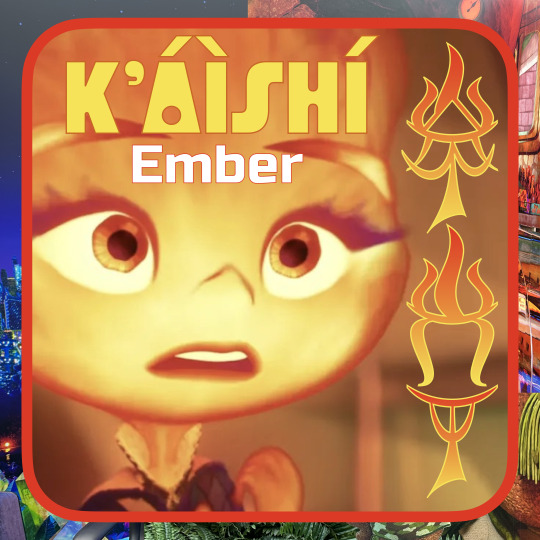
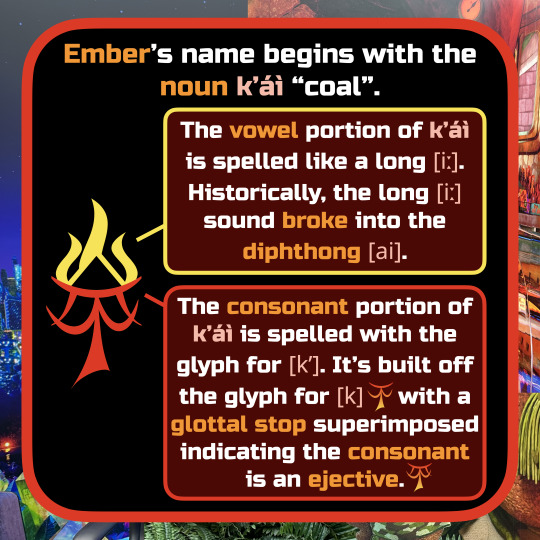


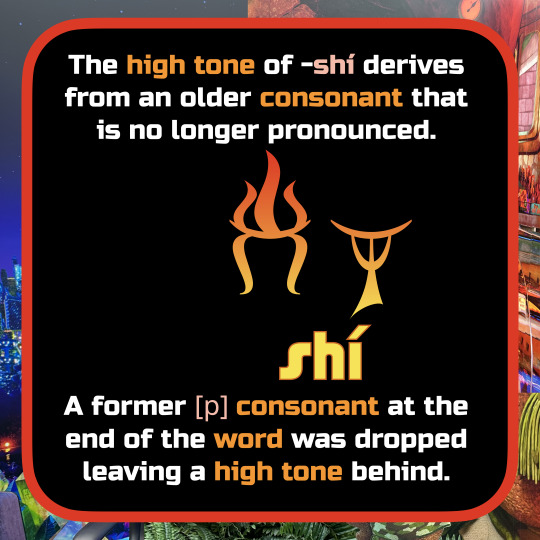

Sharing some Ts'íts'àsh names starting with Ember's. Will share more about the language soon.
#conlang#language#elemental#pixar#pixar elemental#elemental pixar#ts'íts'àsh#ts'its'ash#firish#ember#elemental ember#orthography#conscript#neography#constructed script
623 notes
·
View notes
Text
The Original Uncut Script for ✨The Bear’s Pilot Episode✨ and 🔥Bonus Scenes🔥 I found from it!
- No. 1. Something about Richie being introduced to us as “40, Asshole, Beef Shirt” is poetic to me.

2. Carmy is apparently a lil sneakerhead! Cute!

3. CARMY PUNCHED SOMEONE AT EMP IN NEW YORK? I KNEW IT

4. Apparently Carmy was supposed to have a blow up in front of everyone and scare ts outta them EP 1 😳🤣👀 I feel like they wrote that off to surprise us when Carmy really lost it in the last few episodes of season 1 but damn… also SydCarmy had a lil moment 👀

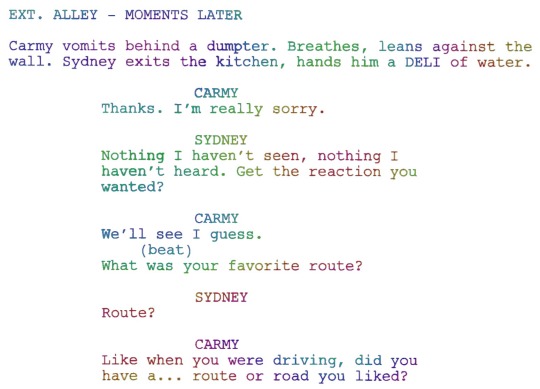
5. Richie kinda inadvertently scared Sydney… put his hand on her waist, what was he thinking? Thank God he’s made a change for the better, he’s much more respectful now.
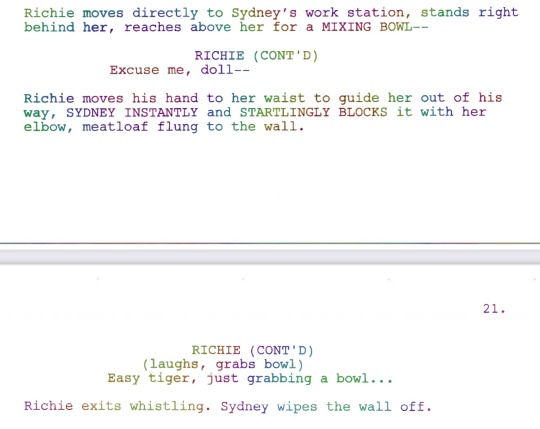
#love this show#sydcarmy moments in there…#sydcarmy#sydney adamu#carmy x sydney#carmy berzatto#syd x carmy#carmy the bear#carmy smut#the bear#the bear tv#x black reader#black women#richie jerimovich#ayo edebiri#ebon moss bachrach#jeremy allen white#scriptwriting#constructed script
87 notes
·
View notes
Text

Arhak astaškiik angkitš'ooqilaap at'giiš.
If you give a man a fish he eats today.
Tiistiluutimatiirivailaap uitani giitsili.
If you teach a man to fish he eats forever.
Ayaak ana šagaleqoq.
But you have done neither.
Agitšinngaanip a'tiigiintu airi a'ntahanngaanip šuuri,
ilaruuts'oq nutl'aat'ooq ngantaharaq nngut'agari.
You have stood before us eating fish after fish and chided us for being wasteful.
Aranngaanip tuuassik yuunnitu a'iimbambairuningaangaa
yahaš ngagati' tiiuyii.
You told us that you own the river and our parents should have
gotten us the same if we wanted fish.
Arhak astaškiik angkitš'ooqavaap ngantaambaitsag
tuuassisii ningii turaš ana arii aap'aap'aš turaš.
You gave a man a fish to murder us if we are too close to the river
or if we speak too loudly.
Astaškilug isawihipannapi ruts'ag.
We must trade fish to you in order to leave.
#conlang#constructed language#translation#conscript#constructed script#artlang#arhanngi#anni#conlanging#my art#translated from a text post by @elymaiis on Tumblr
134 notes
·
View notes
Text

some important words in Ta'mar
157 notes
·
View notes
Text

Working on the modern version of my new language's script, pretty content with this but may change some things.
112 notes
·
View notes
Photo

Yautja Claw
I've been trying to figure out a less... "digital watch" version of Yautja writing for quite a while now. My last attempt was kinda meh, and I think that this time I ended up with something much more satisfying to both write and read.
Posted using PostyBirb
188 notes
·
View notes
Text
FlameGuard Tribe Reworked

H E R E I T B E
I had more writing involving them but ya know, It got lost somewhere, but its also good cause I have a fresh mind to write better. Take note that anything most is going by concept and not 100% fully of cultural accuracy and may lean into animal similarities and/or mindset.
If I recall what I wrote from the past, I wanted to rework on Flametribe cause they could’ve been a nice add in of the story; HOME, since they can easily interconnect with the others in some way. I do not like the fact the author just randomly has a blatant culture without respect nor branching out to flesh the ethnicity, it’s no different when media/companies use ‘ tokens' or checkmarks to fill in, and to avoid being blacklisted. Doesn’t help that the tribes are all cookie-cutter, copy-pasted format.

A mix AWD x Dingo breed Called Emberkin or Caniflamma Nexus
Flame tribe or As I edit their names to Ignisylvan Enkindlers Or Emberfang Tribe for remembrance later, is a AWD and Dingo mixed themed pack around Africa/Australia? They prefer dense forests, and more open terrain with tall grasses.
Belief
Instead of muskrats because ‘teehee funny.’ Laughing at others' beliefs is funny right? Look, I made a joke?…guys…seriously, this could have executed Better on the jokes - it gets cheap and just - lacks taste. Worse it's Rhovanion, a character that is less likely to make jokes like this, Axilyah I would not be surprised.
Their belief revolves around the idea of a sacred bond between the members of the pack, a belief that through their bond, achieving the collective omnipotence and immortality through unity, not for personal gain but for the collective well-being of the tribe and their offspring. This belief emphasizes the importance of a harmonious pack, with leaders serving as immortal parental figures, guiding the tribe through a shared legacy. Rituals and ceremonies reinforce this commitment, celebrating the pack's unity and the perpetuation of their unique cultural tapestry across generations.
Omnipotent Unity:
The heart of the Ember-Fang tribe lies in the concept of omnipotent kinship. The pack believe that by harmonizing their strengths, skills, and unique traits, they can achieve a state of collective power that transcends the abilities of any individual. This union is not just physical but extends to the emotional and spiritual realms, binding the pack members in a profound connection.
Immortality through Legacy:
Unlike the traditional notions of immortality, the Canid union emphasizes achieving a form of everlasting existence through the perpetuation of the pack's legacy. Leaders are considered immortal in the memories of their descendants, as they become the guiding spirits, watching over the pack and guiding future generations.
Parental Figures:
The pack's leaders are revered as the ultimate parental figures, embodying the qualities of both motherhood and fatherhood. They are responsible for nurturing and protecting the younger members, imparting wisdom, and ensuring the well-being of the entire pack. This parental role extends beyond biological relations, fostering a sense of communal care and responsibility.
Generational Tapestries

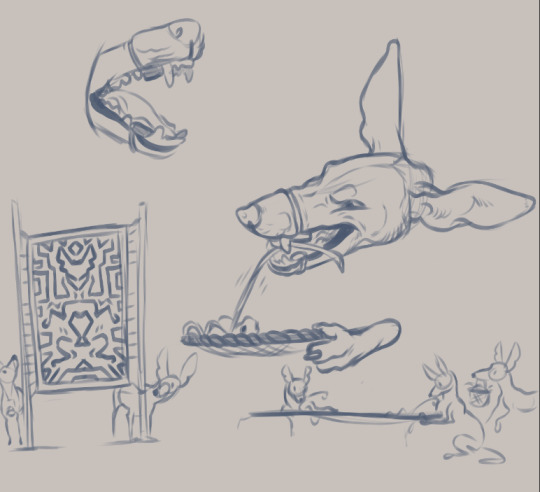
The generational tapestry woven by the canids holds immense significance in preserving the collective wisdom, history, and cultural values of the pack. It serves as a living testament to the shared journey of the tribe, highlighting the contributions of each generation and reinforcing the ideals of the Canid Covenant. Through intricate patterns and vibrant colors, the tapestry becomes a visual representation of the pack's unity, strength, and the eternal bond between its members.
How do the dogs make the tapestries with the limitations?
Communal Weaving: The pack engages in communal weaving, where each member contributes by using their teeth to manipulate and intertwine the fibers. The collaborative effort from all members not only strengthens the bonds within the pack but also compensates for the lack of individual dexterity.
Natural Material Adaptation: The canids select materials that are more manageable with their paws. Flexible vines, grasses, and strips of bark become the primary elements, chosen for their pliability and ease of manipulation. The pack members use their teeth to tear and strip these materials into manageable sizes. additionally, they have contractions that are used by paw and jaws for protection and to make working the material capable.
Terrain Utilization: Rocks and natural formations are employed as makeshift tools. Canids use flat stones to press and secure woven sections, ensuring durability. They may also utilize tree trunks or the uneven ground to create tension in the fibers, aiding in the weaving process.
Tail Assistance: The members cleverly employ their tails to hold and stabilize certain sections of the tapestry as they work. allowing for a more controlled weaving process and prevents unraveling.
Layered Approach: Understanding their limitations, the canids adopt a layered approach to tapestry-making. Instead of intricate, fine details, they focus on bold patterns and larger motifs that can be achieved with their paw-centric techniques.
Natural Dye Techniques: The pack extracts colors from local flora and fauna, crushing berries or plants to create pigments. The canids use their paws to apply these natural dyes, embracing the imperfections and variations in color as a testament to the wild and untamed essence of their craft.
Guidance from Elders: The older, more experienced members of the pack take on leadership roles in the tapestry-making process. They guide the younger canids, sharing their wisdom and ensuring that the traditional techniques are passed down through generations.

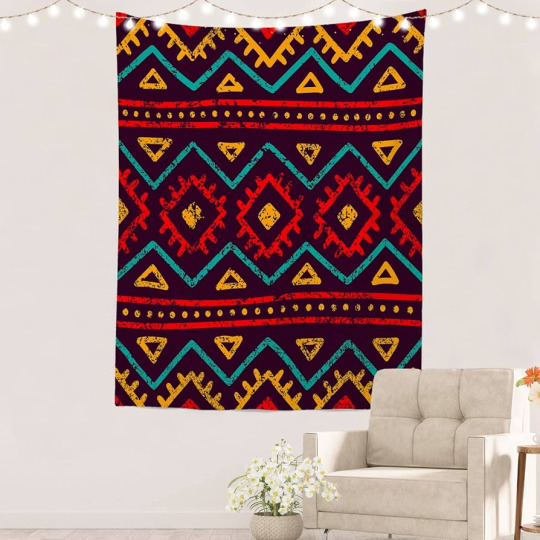
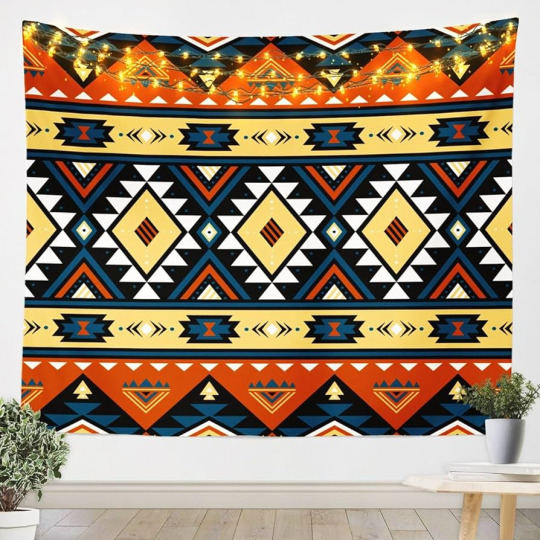

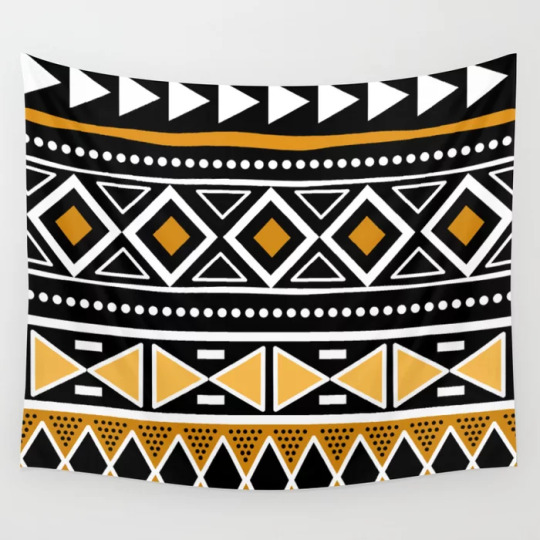
Example tapestries, each tribe has their own distinctive theme and style that makes them unique.
The colors usually being Earthy browns and greens, Bold red and blues and Golden hues. Having symbolic significance to each of these colors. The red and blue are used for important events; successful hunts, important rituals and birth of new leaders while gold is reserved for representations of the leader’s legacies.
Patterns and Differentiation:
Patterns within the tapestry play a crucial role in differentiating between pack and family lines. Each pack develops its unique set of symbols and motifs that reflect their particular strengths, challenges, and cultural nuances. Families within the pack may have individual patterns, creating a subtle but distinguishable thread within the broader tapestry. This visual language enables The Emberkin to identify their own and fosters a sense of belonging and continuity.
As the tapestry grows over the generations, the patterns evolve, incorporating new elements that represent the changing dynamics of the pack. The elders, keepers of tribal wisdom, guide the younger members in maintaining the integrity of these patterns, ensuring that the tapestry remains a vivid reflection of the tribe's endurance through time.
Paint & Scarifications
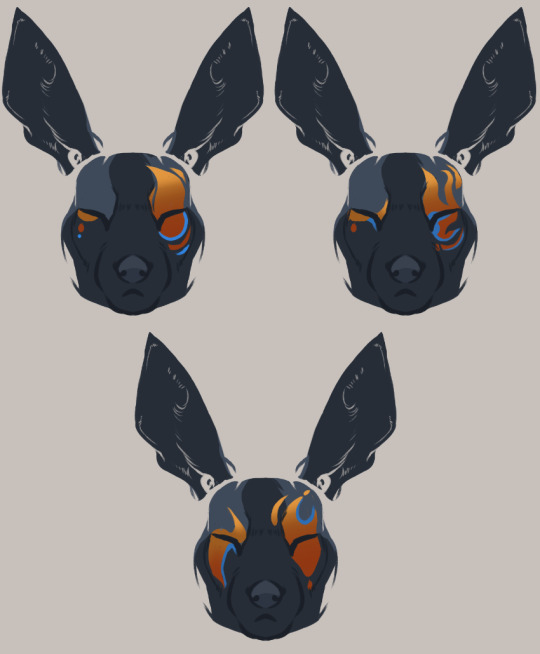
Different ways of painting the fire for either members or tribe.
The Fire color, a vibrant and intense hue, represents the fiery spirit of the pack, embodying qualities such as passion, strength, and the unwavering commitment to the embers.
Members of the pack adorn themselves with Fire-colored paint markings during important ceremonies and rituals. Often take the form of bold streaks or intricate patterns across their fur. The Fire color serves as a visual representation of the pack's collective strength and unity, reaffirming their commitment to the community.
Paint is used mostly on members but leaders are given scarification for identification along with imbedding their beliefs of the pain they’ll endure to protect, nurture and guide the pack and family while also given the blessings from the spirits/gods to guide and protect them after passing the ritual.
The paint contrasting with the Mottle patterns or any in general have a harmonized contrast; bold hues of vivid oranges, deep blues, and radiant yellows are strategically chosen to create a visual contrast against natural tones. The tribes honor their ancestral roots by incorporating patterns reminiscent of ancient symbols or motifs passed down through generations. It is a visual tribute to their cultural heritage and the enduring legacy of the Emberkin.
Scarification:
Scarification practice involving intentional scarring of the skin, is adopted by the canids as a physical manifestation of their endurance, resilience, and commitment to the pack. Scarification patterns are created using sharp rocks or bone implements, leaving lasting marks that tell a story of hardship, perseverance, and integrity.
Parental Leaders' Scarification:
The parental leaders, embodying the ideals of the Covenant. These scars, etched with precision and purpose, symbolize the challenges they have faced and overcome for the greater good of the pack. Each scar carries a specific meaning, representing a lesson learned, a trial endured, or a sacrifice made. Aligns with the pack's commitment to facing challenges, persevering through hardships, and upholding the integrity of the pack.
The use of Fire color in paint markings and scarification reflects the intense energy and enduring nature of their beliefs.
STRUCTURE

Pack Name: Azuflare & Emberfang Family
Within this big Tribe of mixed packs forming one big congruent; Ember and Azu is has the highest amount of living members integrating and contributing to the diversity of a larger community.
Hierarchy and Role
Parental Leaders:
Osiris and Kellan, as the parental leaders, hold the highest rank, making crucial decisions for the combined Family's survival and well-being.
Elders:
Elders provide wisdom and counsel to the pack, offering valuable insights based on their experiences. Their role is respected, and their guidance influences major decisions.
Huntmaster:
The Hunt masters oversees the pack's hunting endeavors, ensuring a stable food supply. This role is crucial for the Emberkin Family's survival in the harsh wilderness. They're also the one's to defend the tribe and be sent to battle, for many members take this role if not an artisan.
Artisan:
The Artisan is responsible for preserving cultural traditions and crafting essential items for the pack. This role upholds the Tribes identity through artistic expression and practical skills.
____________________________________
Leadership Structure:
The Emberkin and Azuflare Family operates as a close-knit pack descended from their sole leaders, deeply loyal and bound by strong family ties. The parents, as the pack's leaders, hold a revered position, and abandonment by parental figures is considered a severe transgression.
Attitude Towards Betrayal:
Betrayal is taken extremely seriously within the tribe. The consequences are so profound that they may extend to wiping out an entire bloodline, holding a deep-rooted grudge against any surviving children. Leaving the pack without proper permission and introduction can lead to tensions within neighboring packs, emphasizing the tribes commitment to respect, etiquette, and preventing unnecessary conflicts.
Grudge and Retribution:
The Emberfang tribe carries a deep, guttural grudge, and those who abandon their own are not only ridiculed but also hunted down or forced out of the area. Packs or alliances harboring such traitors face similar condemnation until the grudge is resolved.
Cultural Traditions:
Within the tribe, outside marriage is uncommon for those without ancestral connections. Arranged marriages are prevalent, especially when forming alliances with other packs. The Tribes, with the ancestral syllables, represents separate family lineages arranged by tradition.
Alliance and Disapproval:
The Emberfang Family values alliances but is cautious in forming connections. Packs harboring traitors are deemed as traitors themselves until the matter is resolved. This emphasizes the Emberfang commitment to loyalty, respect, and preserving the integrity of their lineage.
In essence, the Emberfang and Azuflare Family is a deeply rooted, conservative pack that values family, loyalty, and respect. Betrayal is met with severe consequences, reflecting their commitment to maintaining the honor and unity of their bloodline. The ravel cultural dynamics, arranged marriages, and the cautious approach to alliances underscore the tribes' adherence to their unique traditions.
Brief Backstory
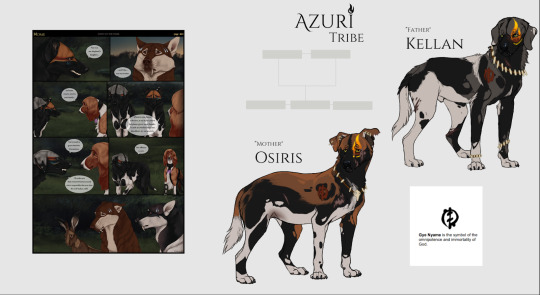
They were originally Azuri/Azura but changed to Emberfang Tribe
_____________________________

Osiris:
Osiris exudes a fiery and passionate demeanor, driven by a deep sense of loyalty and protectiveness toward her family. Her emotions can be intense, especially when the safety of the pack is at stake, leading to fiery outbursts that reflect her protective instincts. Osiris is quick to respond to threats, sometimes allowing her emotions to momentarily blind her to reason. Despite this, her heart is steadfastly devoted to her family, and she possesses a fierce determination to ensure their well-being. Osiris values tradition but is willing to challenge norms for the sake of her family's survival.

Kellan:
Kellan embodies a calm and composed nature, providing a stabilizing presence within the Emberkin Family. He is slow to anger, thoughtful, and methodical in his approach to challenges. Kellan's phlegmatic temperament makes him a patient and understanding mate to Osiris. While he may not share the same intensity of emotions as Osiris, Kellan's steadfastness serves as a crucial anchor for his mate during moments of fiery outbursts. He values harmony and balance within the pack, often playing the role of a peacemaker. Kellan's wisdom and measured responses complement Osiris's fiery nature, creating a dynamic partnership.
Dynamic and Contrast:
Osiris and Kellan's personalities create a dynamic contrast within the Emberkin Family. Osiris's passionate and impulsive nature contrasts with Kellan's calm and methodical approach. While their differences occasionally lead to conflicts, their individual strengths complement each other, forming a powerful synergy. Osiris's fiery emotions are tempered by Kellan's calming influence, and Kellan finds strength and purpose in Osiris's fierce determination. Together, they form a united front against threats to their family, becoming a formidable duo that outsiders and enemies approach with caution.
_____________________________
Summary: Emberkin's Descent into Deception
In the heart of Emberfang traditions, Osiris and Kellan's union emerged from the intricate tapestry of predetermined matches between packs. Osiris, with her fiery spirit and unwavering loyalty, represented the Emberkin Family, while Kellan, known for his composed nature, stood as the chosen mate. Their union, crafted for strategic alliance, initially bore the strain of their contrasting personalities.
As Emberkin parental leaders, Osiris and Kellan faced a medical crisis as Osiris was a soon mother to be, prompting an alliance with the Capitol despite it not favored by their culture. the decision that would unravel and crumble in the face of a brutal wolf attack ( Jahla & Thakir ). Among the losses were family members, including Osiris's brother Taku and Anzi, the daughter of an artisan. Nursing emotional wounds, Osiris and Kellan severed ties with the Capitol, forging a path marked by unconventional alliances.
The emotional toll of family losses tested Emberkin resilience, propelling Osiris and Kellan and surviving member's to hold through on their own. With Osiris's fiery determination, a force driven by her loyalty to family, found balance in Kellan's patient guidance. Together, they navigated the aftermath of tragedy, seeking now vengeance against Jahla and Thakir, wolves responsible for the massacre.
In a morally complex choice, the Emberfang tribe aligned with Ranach, an exiled outsider with selfish motives. While Jahla and Thakir fueled the Emberkin's quest for justice, Ranach's manipulation threatened the family's integrity. The Capitol's favoritism towards wolves added another layer of complexity in their journey.
Osiris and Kellan's love, born from a predetermined match, evolved beyond tradition, becoming a testament to unity and the strength found in embracing the hardships. Their journey, marked by challenges, alliances, and love, painted a tale of survival, deception, and the resilient spirit of the tribe.
Emberkin Coat Variations and Markings
[ Pic ex ].
Inheriting a default black hue, Emberkin coat genetics showcase a diverse array, including liver, darker tan, and red variations. Pups with ginger and yellow coats often thrive in desert and plains territories. The rarest hues, such as diluted blues and faded Isabellas, add a touch of uniqueness.
Emberkin coat patterns draw inspiration from African wild dogs and Australian Dingoes. The base coat's darker tones serve as an ancestral foundation, aiding in the prominence of distinctive markings. Mottled, tricolored, or two-toned patterns embellish the coats, manifesting as either subtle fades or bold, pronounced blotches.
The choice of darker base coats among the Emberkin is not merely aesthetic; it serves a practical purpose. These common coat patterns contribute to the perception of health and provide effective camouflage during hunting, particularly in the dim light of dusk and nightfall. The mottled, tricolored, or two-toned markings enhance their adaptability in the wild, allowing the Emberkin to blend seamlessly with their surroundings.
Page Edit

Script Rewritten
It's more better and correlates to the information here;
Scene: EmberFang Family Confronts the Capitol
The Emberkin Family, led by Osiris and Kellan, confronts the Capitol officials, expressing their discontent with the perceived favoritism towards the wolves and unprofessionalism.
Osiris (fiery determination):
"We did not forge alliances and shed blood to be treated as expendable pawns! Our family suffered losses, and what did the Capitol do? Turned a blind eye, favoring wolves over our kin!"
Kellan (composed but firm):
"We seek unity, not divisive favoritism. Your actions endanger the delicate balance we've strived to maintain. We won't tolerate such disrespect to our family or any other tribe."
Capitol Officials, taken aback, attempt to explain their decisions.
Capitol Official (defensive):
"It's a matter of strategy. Wolves provide a different kind of strength, and we have to make decisions that benefit the Capitol and tribes as a whole."
Osiris (indignant):
"You speak of strength, yet you disregard the strength forged through generations of our unity. We won't stand by and watch our family's sacrifices belittled for political convenience."
Kellan (calm warning):
"Spread the word to your superiors. The Capitol's unprofessionalism won't go unnoticed. Favor wolves if you must, but know that other tribes will hear of your betrayal."
The Emberkin Family, fueled by a mix of anger and determination, leaves the Capitol, severing ties that were once deemed essential for survival. As the Emberkin Family readies to leave the Capitol officials, Jahla, Thakir, and a rabbit happen upon the scene, drawn by the outcries and angry growling. The leaders stop for only a moment, but a moment enough for the Capitals last whine of intervening.
Capitol Official (pleading):
"Leaders, please see the reason! The wolves, in their instinctual defense, are willing to compensate the tribes for any losses through alternative means that avoid bloodshed. Moreover, the Capitol is prepared to contribute their own compensation to ease the burden. Please, Consider the greater benefits!"
The Capitol's words like a slap, anger and baffle the leaders even more, intensifying the confrontation.
Osiris (furious):
"Benefices? Compensation? Your blindness astounds me! We won't be swayed by your audacity!"
Kellan (disgusted):
"You speak of reason, yet you fail to recognize the pain and loss inflicted upon us. Your ignorance is intolerable!"
Osiris (sensing the haunting echoes of the past):
Despite the Capitol and others not smelling the iron scent, Osiris pinpoints and familiarizes with the old blood of her dead family, lingering through the air like an ominous taunt. Osiris sharply locates the smell to Jahla and Thakir. Them.’ How dare they show their faces after the murders have they no shame’, It took every fiber of her being to hold herself back. Resolving to leave with her mate, Kellen, both simmer with a quiet rage, their departure laden with an unsettling discontent.
Jahla (shivering with fear and sadness):
"What have we walked into, Thakir? Their anger is...overwhelming."
Thakir (solemn):
"We are witnesses to a storm, Jahla. A storm we might get caught in if we're not careful."
Rabbit (eyeing Jahla wearily):
With weariness, the rabbit observes Jahla, sensing the impending turmoil.
As Osiris and Kellan leave, the Capitol Officials, saddened by the loss of the alliance, reflect on the consequences of their decisions. Jahla shivers with fear, Thakir remains solemn, and the rabbit watches Jahla with a wary gaze.
__________________________________
Thank you everyone who made it this far, and Hope you enjoyed this meaty blog and that the rewritten tribe adds more depth and interests.
Ps...if this ends up being snuck into home, just so you know, I'm the OG that did it.
#home comic#asmundr#asmundrhome#home#kique7#kique#asmundrcomic#kique nordin#kiquenordin#bad dog comics#concept art#character concept#character#concept writing#constructive critism#constructed script#rewrite#;all fleshed out#above and beyond#canine#animal fantasy#xenofiction#i had fun#but#its exhausting#rework#bad webcomics#webcomic#comic fix
36 notes
·
View notes
Text
Sunitian Written Language V2

Sunitian is a phonetic pidgin language created to allow all three sapient species communicate. It is based on constellations and moon cycles under the belief that no matter how different, all life shares the stars and moons.
This is the revised version (and hopefully final!) version of this language! :D I figured that having less angles would make for clearer reading. Along the bottom right are some examples of names written using the language!
Let me know what you think! Tell me if you like it or if you having any suggestions!
16 notes
·
View notes
Text
Téjúda

A script commission for @cookie-dog-69 and their conlang Minké.
An alphasyllabary with standalone shapes for non-CV bound vowels. Base-8 numeral system and an interpunct for highlighting spaces between words.
I say it's very pretty! Customer and creator both satisfied.
38 notes
·
View notes
Text
: Undertale :

30 notes
·
View notes
Text
Ts'íts'àsh Language from Elemental
Hey, I just wanted to throw this out there. I've been getting a lot of requests for info about the Ts'íts'àsh language from Pixar's Elemental, and I totally want to answer them, but I did want to make something clear. While this is my Tumblr (so I'll be answering asks, etc.), I didn't create the language by myself. Jessie Sams and I created the language together.
Now, when I say that, you might think like I did the nouns and Jessie did the verbs, etc., but that's not really how we work. We sit down together with our laptops on the couch working on the same document in Pages (shared via iCloud), and we sit there and create every single bit of the language together. There's no part of it you can point to and say that it's all me or all Jessie: The whole thing is us. That's how we work.
If you've sat through the credits of Elemental, you'll see that only I'm credited. That was, in a word, bullshit. We also had no control over it. We can say whatever we want ahead of time, but who gets credited—or whether we get credited at all—is totally at the mercy of the studio. Even when it's written into our contract it sometimes doesn't happen. We noticed that we didn't get the credit in our contract for Peacock's Vampire Academy, and we complained, and the best they could do is credit us in the episodes they hadn't finished yet—the last one. And so we're in the credits only for the very last episode in which we have no lines.
This is an unfortunate part of the job. As language creators, no one in Hollywood knows what we do, and they certainly don't care if we don't get credit. It's up to us to make sure people even know that we worked on something.
Anyway, in this case, it's really important to me that everyone knows this was a joint project of mine and Jessie's. It's our work, and we deserve equal credit.
#conlang#language#quothalinguist#jessie sams#elemental#pixar elemental#elemental pixar#tsitsash#ts'its'ash#ts'íts'àsh#hollywood#language creation#orthography#neography#conscript#constructed script
376 notes
·
View notes
Text

I'm still working on this, unfortunately the letter H is giving me the troubles.
86 notes
·
View notes
Text

Assik turunngussii ga'taamassaitik aliišuuri
Water was poured into a pot one morning causing me to wake
poqapuunni šaarhapia
you were making tea
unni nngorhagaš, amauiiš
a usual, daily sound
ayaak at'matišaap narahisa
but suddenly I knew that you loved me
matiišulaak
an unheard of thing
naraasa taarheeqiississii
tuunilainniig.
love heard in the sound of pouring water.
#conlang#constructed language#translation#conscript#constructed script#artlang#arhanngi#anni#poem#The teapot by Robert Bly
99 notes
·
View notes
Text

new writing system test for new conlang lahkantha. orthography not set in stone at all this was just to try it out and to try to hammer down the style/feel of the script
17 notes
·
View notes
Text
The Collective Seraphic Writing System
This post is going to be the one dedicated to explaining how the Seraphic writing system works. This writing system is entirely digital, as physical writing is no longer in everyday use throughout the Collective, so it's a bit inconvenient to actually write out. It's also weird to read, because it's written in a way that makes the assumption that you know how to speak and understand Seraphic, but I'll try to explain what I can.
Seraphic has two written forms: longform and shortform. Longform is used primarily to teach young instars how to read and write, and as a way to show how a shortform word is meant to be read. Shortform is the main form of writing, and due to its complication it's usually put off for a year or two before being taught in pupariums. Shortform is the method I'll be teaching today. It's primarily morpho-phonetic, with elements of both an alphabet and grammatical logograms, and is written bottom-to-top and right-to-left in reverse boustrophedon (the path of writing goes up, flips 180°, and goes back down). Because of this, you're expected to be able to read both right-side-up and upside-down. For this post, I'll be using an example sentence to highlight specifics areas of the writing system, as shown below:

It reads: nJasāğn k'œ̄nan ālxōr e-fya.
"There are 16 dull knives on the floor."
There are seven elements you need to be aware of when writing in Seraphic: the alphabet, class cartouches, procedural and plural ligatures, preposition glyphs, tone diacritics, numerals, and punctuation. I'll be going through each one step-by-step.
Alphabet

The alphabet makes up the majority of Seraphic writing. There are 30 consonants and 6 vowels, and they all arrange into syllable blocks called "cells". Each consonant takes one of three forms depending on if it is at the start of the syllable, before a vowel, or at the end of a syllable. The alphabet is featural, meaning that the way each letter is written is meant to encode its pronunciation. Here is the alphabet in full:

Each consonant (excluding the ejectives) showcases the three variant forms it can take (similar to capital and lowercase letters in the latin alphabet). The largest, leftmost character is the form that hosts the interior vowels within it. The rightmost vertical form is used when preceeding another consonant, and the upmost horizontal form is used at the end of syllables. If a syllable contains a syllablic consonant, the main consonant will have no vowel within it and instead a syllable-final form of one of the syllabic consonants (r, l, m, n, or ŋ) placed on top of it.

Concerning vowels, they are solely meant to be written within consonants, acting sort of like internal diacritics. They cannot exist on their own, nor can more than one be written within the same consonant (Seraphic doesn't allow diphthongs), and if a vowel must be written by itself it is written within the glottal stop letter ' (in this instance acting as an independant vowel holder).

These rules apply to individual syllables. In multi-syllabic words, each syllable cell is arranged together in a specific way based on the number of syllables in order to keep the line uniform and compact.
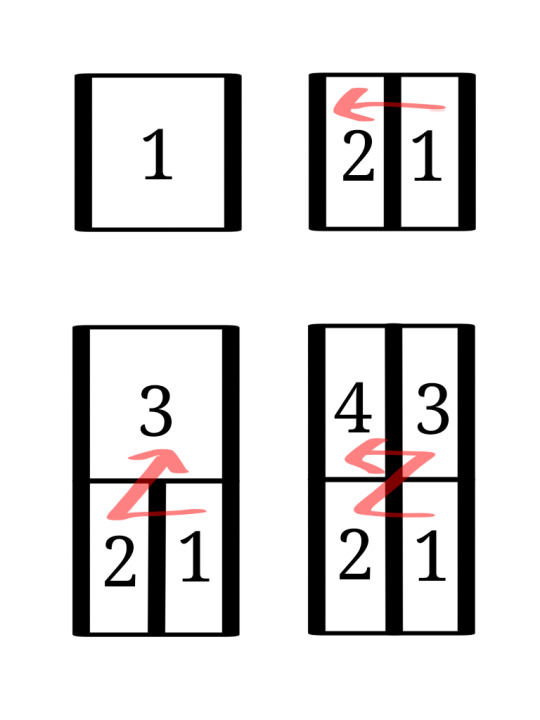
the flow of reading word-internally definitely follows the overall direction of writing (bottom-to-top, right-to-left) so broken down an entire word will usually look like this when written:

Seraphic written in longform will be written entirely using the alphabet. Spaces are put between words, punctuation and numeral symbols are still used, and tone diacritics may be included as well, but otherwise it's entirely spelled out in this way. Writing this way makes the text as a whole quite longer, and can come off as childish or imply you're a new learner of Seraphic, so shortform will usually be used in official contexts. In shortform, alphabetical letters are restricted to non-declined parts of nouns, adjectives, and proper nouns.
Class Cartouches

In Seraphic, there are seven noun classes: Solar (people), Astral (animals), Vital (plants), Terranean (places), Metallic (objects), Lunar (concepts), and Oceanic (everything else). Similarly, the writing system employs seven symbols called "class cartouches" to encode which noun class a word is in. This is drawn from this writing system's predecessor, the Aeonic Seraphic alphabet, that also used glyphs to notate class. These are the seven noun class cartouches:
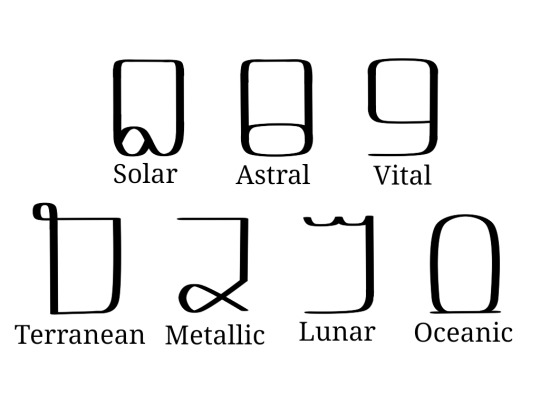
The thing about the class cartouches is, not only is it morphological, but it's also phonetic. A noun is never spelled out in its entirety, usually only part of it is. When a class cartouche is used, it's supposed to stand in for the class prefix itself without having to additionally spell the class prefix in the rest of the word. For example, in the word zājlux (tail), the "-jlux" would be spelled out, and the solar class cartouche would be drawn around it to stand in for the "zā-". Even though you don't write it, you still know it's there because of the class cartouche. Because of the nature of the noun class prefixes, and how many different forms they can take, it can be daunting to have to guess if you're supposed to pronounce a word with a "za-" or a "zo-", but there are patterns to which prefix (and thus, declension patterns), is meant to be read depending on what the following sound is.
Solar class
read as zā before f, v, s, z, c, j, pf, ts, tc and any cluster of two consonants (e.g. zāsā, zāfr, zājlux)
read as zō before x, ğ, h, ', and kx (e.g. zōxō, zōxur, zōğœcl)
read as zē in stressed syllables, and occasionally before consonant clusters (e.g. zēzmp'ux, zēzt'e, zēvasax)
read as s before vocalics (vowels and syllabic consonants), r, l, w, y, n, t, d, p', or k' (e.g. srāc, sēr, sōğœc)
read as ts before t', the ts replacing the t' entirely in pronunciation, for example tsn would be written as (Solar)t'n (e.g. tsn, tsā, tsłzaf)
Astral class
read as ğr before f, v, s, z, c, j, x, ğ, h, pf, ts, tc, kx, p', t', k' and and cluster of two consonants (e.g. ğrzles, ğrxur)
read as x before vocalics, r, l, w, y, ŋ, k, g, p', or t' (e.g. xūc, xŋox)
read as kx before k', the kx replacing k' in pronunciation (e.g. kxa)
Vital class
read as wā before r, l, w, or y (e.g. wāya, wārāc, wāwax)
read as wō before k', k, g, x, ğ, ŋ, or kx (e.g. wōk'ł, wōxur, wō'ōf)
read as wē before consonant clusters (e.g. wēzles, wējlux, wējlozln)
read as ū before n, m, p', p, b t', t, d, f, v, s, z, c, j, pf, ts, or tc (e.g. ūt'u, ūp'n)
read as w before vocalics (e.g. wē, wīn, wājr)
read as wī occasionally before consonant clusters (e.g. wīzya)
Terranean class
read as va before f, v, s, z, c, j, pf, ts, tc and any cluster of two consonants (e.g. vafl, vasērn, vasa)
read as vo before x, ğ, h, ', kx, and consonant clusters (e.g. voxāl, vodsā, vojrayux)
read as vu in stressed syllables and occasionally before consonant clusters (e.g. vujlux, vulvren, vuzajni)
read as f before vocalics, r, l, y, w, m, n, ŋ, p, b, t', or k' (e.g. fe, fruvn, fmağo)
read as pf before p', pf replacing p' in pronunciation (e.g. pfan)
Metallic class
read as ja before f, v, s, z, c, j, pf, ts, tc and any cluster of two consonants (e.g. jafa, javlni, jawaya)
read as jo before x, ğ, h, ', and kx (e.g. joxl)
read as c before vocalics, r, l, w, y, n, t, d, p', or t' (e.g. can, cya, cenaŋx)
read as tc before t', the tc replacing the t' entirely in pronunciation (e.g. tcłvr, tcāŋğl, tcū)
Lunar class
read as la before r, l, w, or y (e.g. lara, layeğr, lalel)
read as lo before k', k, g, x, ğ, ŋ, or kx (e.g. loxir, loğn̄, loxel)
read as le before consonant clusters (e.g. levp'ā, levren, lejt'ān)
read as li in stressed syllables and occasionally before consonant clusters (e.g. liwayi, lit'n̄, livasāx)
read as y before vocalics (e.g. yar, yu, yawu)
read as l/ł before n, m, p', p, b t', t, d, f, v, s, z, c, j, pf, ts, or tc (e.g. lce, łzēwok'u, lvulvren)
Oceanic class
read as a/ā before m, n, p', p, b, t', t, d, s, z, f, v, c, j, pf, ts, tc, w, r, y, l, and all consonant clusters (e.g. ap'i, āt'ē, ācèya)
read as o/ō before ŋ, k', k, g, ', x, ğ, h, and kx (e.g. ōxūr, ōxān)
read as aw/āw before vocalics (e.g. awun, awaf, awaman)
Of course these rules are not hard set, and there are several instances where a written word contradicts these rules or even when two words end up spelled the same, but for the most part these rules will generally be consistent for most written words. It seems like a lot to remember, but usually it's a thing that you eventually develop a sort of "ear" for.

Procedural and Plural Ligatures

The procedural and plural ligatures are additional glyphs used to mark, respectively, the procedurals and the plurals of a noun. The procedural are written at the bottom of the noun (since Seraph is written bottom-to-top and these are prefixes of course), and there are 12 separate procedural symbols in use. Similarly, the plurals, being suffixes, are written at the top of the noun and contain only three symbols (the singular is usually unmarked). They are as follows:
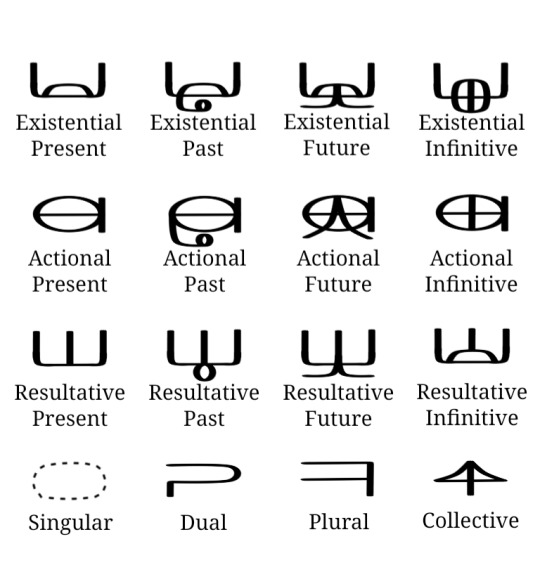
The plural ligatures attach to both nouns and adjectives freely, but in order for a procedural ligature to attach to an adjective, the adjective needs to be put in the oceanic class and subsequently written with the oceanic class cartouche. Additionally, if you want to write remote past/future forms for each procedural, you would need to attach the resultative present ligature underneath the preexisting past or future ligature (these conjugations haven't developed their own separate ligature forms, so they follow the tradition of using the resultative in addition as semantically that is where the remote forms originated). I don't really have a way to show you how to pronounce the plural forms, as even though the different pronunciations are pretty few they're actually pretty inconsistent on which one goes where. It's just one of those things you kinda have to already know. You can check the introduction to Seraphic post to see what forms the plurals can take, but otherwise it's basically, like, memorization. The procedurals on the other hand DO have a predictable pattern of pronunciation, but each tense has a different form based on what class and declension the noun is in, and with six tenses and seven classes each with at least three different declension forms, it's definitely something I can't summarize here. Again I HAVE to make a separate post for that because the declension forms are vital to knowing how to decline properly in Seraphic.
Preposition Glyphs

This section will probably be the easiest to explain really. The preposition glyphs are pretty easy to recognize. They're written in between words, attaching to both of them instead of floating freely like regular words are. There are 19 glyphs for the 19 prepositions, and they don't really change form. Sometimes, if occurring at the beginning of a sentence, they'll have one end sorta lopped off, but not everyone follows through with this convention. Here are the glyphs listed below:
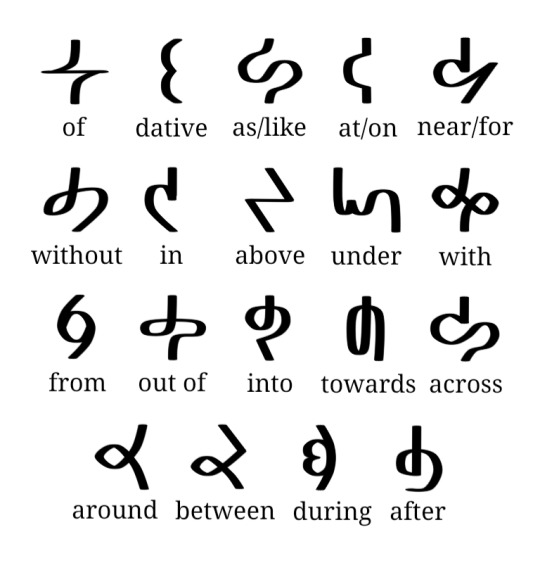
Two or more prepositions can't occur sequentially, it's a very one-at-a-time situation, although in colloquial speech you'll see two prepositions being used in certain instances.
Tone Diacritics

Seraphic is a tonal language, and luckily it has diacritics to indicate the tones. They frame the words on each size, being used on both nouns and adjectives where applicable. You'll usually see them in formal contexts like government documents and letters of address, on signs and boards and menus and any kind of display especially in highly populated areas, in use by those whom are just learning Seraphic and don't have a hang on remembering all of the tones yet, and just in any context where clarity of literacy would be important. In everyday colloquial text conversations and things the tone diacritics will be usually dropped as context is sufficient enough to know, although tone diacritics may be reintroduced to differentiate homonyms that are distinguished only in tone (e.g. lxal "power" vs. łxāl "day"). There are eight individually recognized tone diacritics:

The low tone is the base tone and is usually left unmarked, so there's no sign for just the low tone. When a low tone transitions to a rising or falling though, the low transition diacritic will be used to connect the two. Many of these diacritics are usually connected consecutively when a word requires it, flowing as if they're one larger tone diacritic. This can give a whole host of unique tone symbols, but for the most part, all of the tone symbols can be broken down officially into the 8 diacritics. There isn't a 1-1 correspondence between individual tone diacritics and syllables within a word, usually you can know from context and just knowing how the word is pronounced. For example, the word łxāl would be written with one high tone marker even though the word is two syllables, but it's meant to infer that the entire word is pronounced with an even high tone. Here are some additional examples:
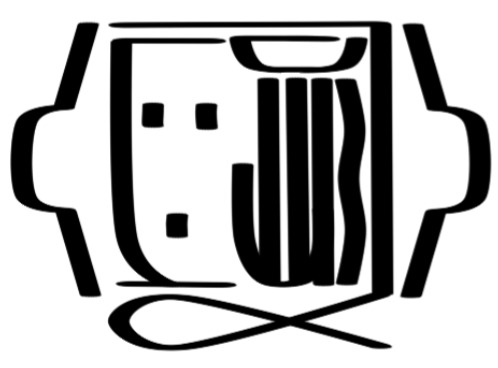
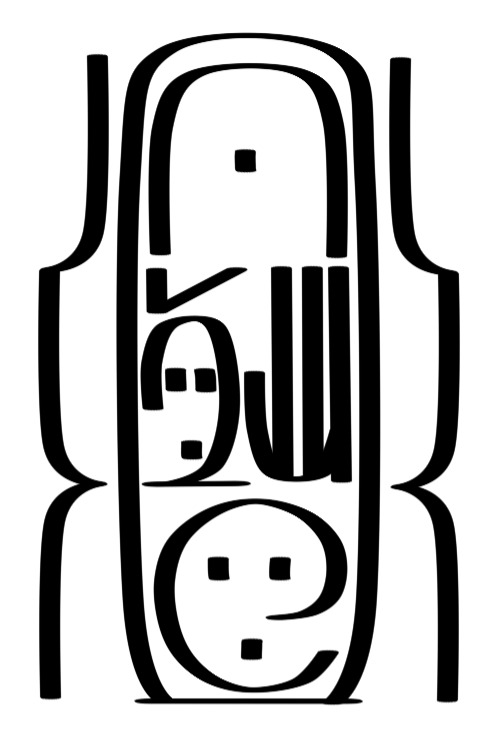
The top example is the word jalzègxa "chronicle". You can see that it uses the two low tone transitions to connect to the central falling tone, representing a low-falling-low relationship. The word below that is māzefādnu "hourglass". It employs a high-low-high, and then a high-low, with the last high-low meant to merge with the high-low-high. So truthfully it's meant to be interpreted as high-low-high-low. There's a lot of possibilities, but breaking it down will simplify what tones are being used specifically.
Numerals and Punctuation

This final section will discuss Seraphic numerals and punctuation. Now, unlike in most human languages which uses base-10, having 10 unique symbols to represent the values of 0-9, Seraphic uses base-16 and represents the values 1-16 with 16 individual symbols. In base 16, we would write 16 as 10, standing for one set of 16 and zero sets of 1. It's written in positional notation like arabic numerals, where each position represents a power of 16 (instead of a power of ten like in base-10). Here are the numerals:
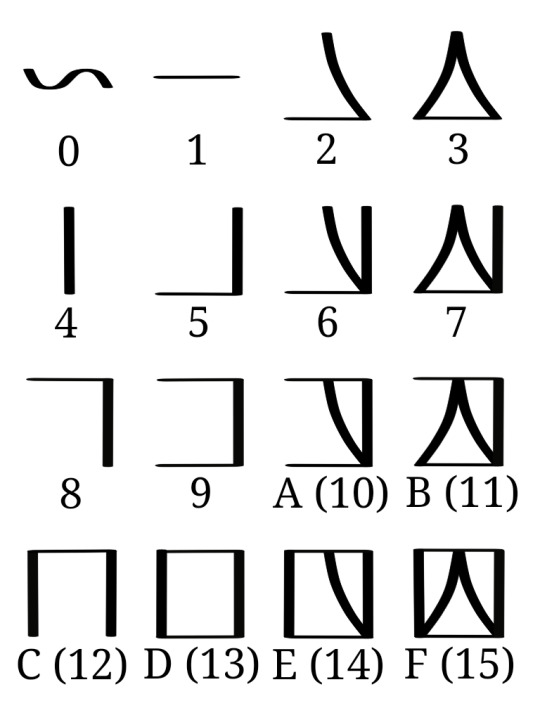
If you were to write a number like 299,792,458; you'd convert it into base-16 which would be 11,DE7,84A; and since Seraphic numerals are grouped in 4 instead of 3 it would actually be 11DE,784A. This is how you'd write that:
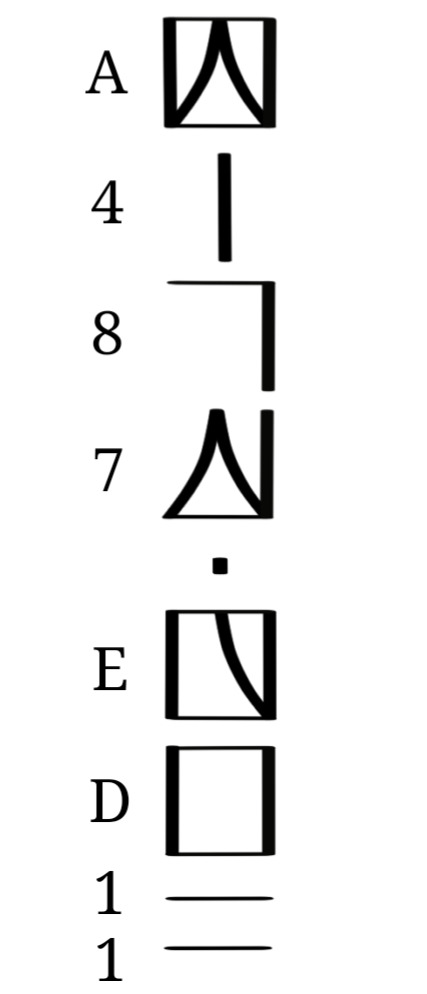
Both Arabic numerals and Seraphic numerals describe the same amount of things, they just group things differently. We group in sets of 10, they group in sets of 16.
As for punctuation, there are only 5 marks that's in standard use, and these are them:
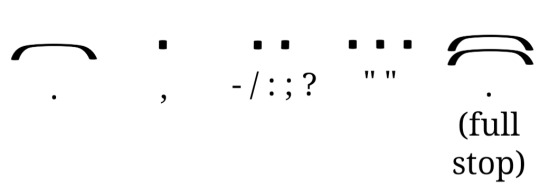
Single bar - separates individual sentences.
Single dot - separates clauses for clarity, separates numerals into groups of four.
Double dot - separates individual words such as in lists or replaces a single dot when separating clause groups.
Triple dot - Distinguishes quotes and dialogue, as well as highlighting names, terms, and titles.
Double bar - used to end full paragraphs/passages instead of a single bar.
Overall, that's pretty much everything I can detail about how the Seraphic writing system works! It's complicated but it was very fun to develop and boy was it satisfying to get it to work. Hopefully you'll now be able to decode a little better Seraphic writing, and maybe even write something of your own!

ŋKowīci cu-stux 'ōf tsa-levp'ā cu-zāsláf pi-lizt'n ğōdjasa! (Thank you all so much for reading!)
#conscript#constructed script#neography#conlang#constructed language#artlang#writing system#orthography#seraphic#collective seraphic#whoa boy this one is even longer#had to do a lot of writing and doodles for this#of course i needed them so itd all make sense#i needed to provide examples#either way i hope this made any sort of sense#ill provide the declension forms soon enough and that should be relatively shorter#idk if it'll be easier to explain though#eh whatever
44 notes
·
View notes
Text
Here is an alphabet-abugida mix script for my conlang.
This is my third attempt at it, and this one was inspired by devanagari

Here's an horribly handwriten bit of "the north wind and the sun" translated and put into script.

I really like how it came out, it doesn't feel too forced like my previous attempts, this one feels natural.
#conlangs#conlang#neography#language#languages#calligraphy#devanagari#conscript#constructed language#constructed script
7 notes
·
View notes